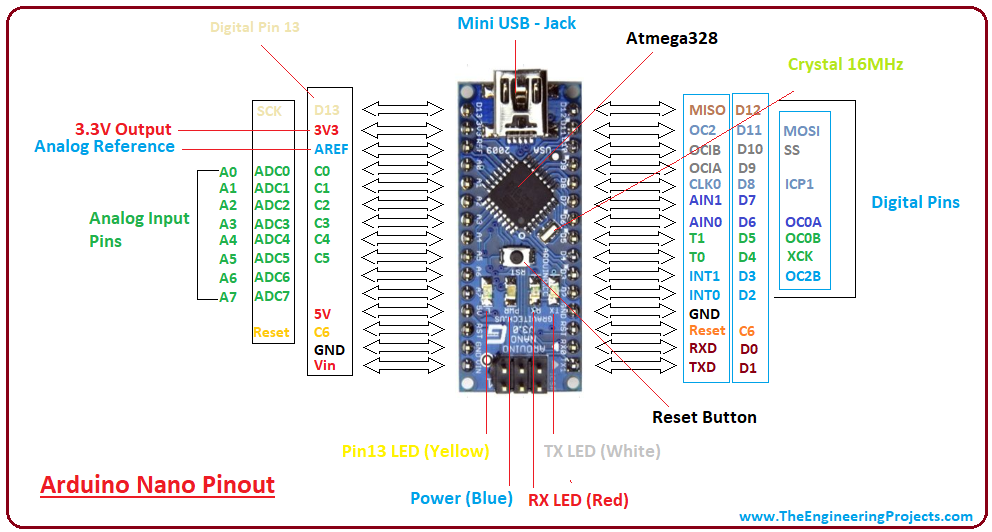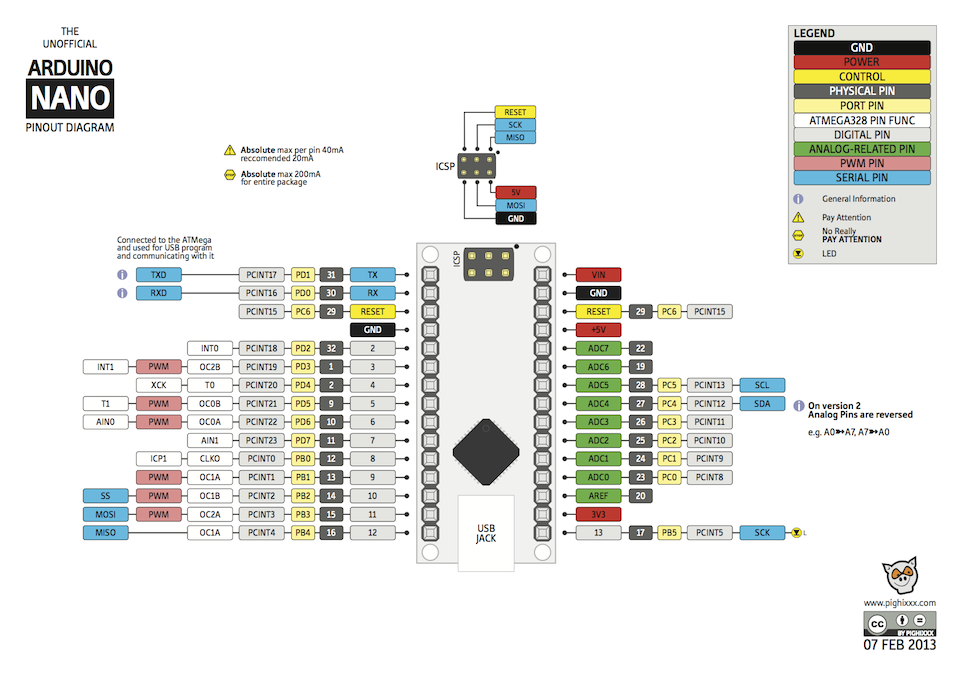
One of the factors that has made the Arduino so appealing to There’s actually a lot going on under the hood here that you areīlissfully unaware of.
#ARDUINO NANO PINOUT ISP CODE#
To concern yourself with device programmers, fuse settings, etc.Įvery time you press “Upload” in the Arduino IDE, your code builds and is magically sent Hobbyists are to have access to the Arduino system. I only recount this to illustrate how far things have come and how lucky makers and Released an IDE that made them relatively easy to program and debug.īy the early 2000s I was amazed to be able to purchase a programmer for the PIC that cost Range of cheap microcontrollers, made them widely available in a DIP package, and even So there were virtually no resources for sharing designs and libraries, so everyone wasīut in the late 90s things started to change. It seemed it would not be long beforeĮvery device was in a completely inaccessible BGA package. Getting ever more powerful but physically smaller. Know if it worked until I got home, and then I’d have to wait until the next day to fixīy the mid 1990s it seemed as though tinkering with micros was a dying art. Programmers and UV erasers to actually get the code onto a chip. Lunch hour, or staying late, I’d take the opportunity to use the company’s EPROM In the evenings, often with a “liberated” copy of a compiler. In the 1990s, as a young graduate engineer, I used to write the code for my hobby projects Programmers and SDKs typically cost thousands, as they wereĪimed squarely at embedded systems professionals. Proprietary toolchains, dedicated (and expensive) programmers, and outdated physical Not very long ago, programming firmware on microcontrollers was somewhat more difficult. I won’t assume much else.īuy Genuine Arduino Nano from Amazon Background on Programming AVR Devices Programming Microcontrollers: the Bad Old Days… This is a hardware project, I’ll also assume you understand the basics of electronics,īreadboarding and soldering. In this tutorial I assume you’re already familiar with the Arduino IDE and hardware. What You Should Already KnowĪ few prerequisites are in order before we dive in. Nano, and of those that did, none were targeting 14-pin devices such as the ATtiny44. People have flashed lots of AVR chips with an Arduino, but I couldn’t find many using a And a quick google turned up a lot of conflicting information. I wanted all theĮlectronics to fit neatly behind the keypad and the Arduino would have added too much depthīesides, it had been many years since I’d last programmed a raw microcontroller and I felt System, it seemed wasteful to use a complete Arduino in the final build. Keypad decoder was going to be merely a peripheral, connected via I2C to the rest of the I had prototyped it using an Arduino Nano (my favourite Arduino), but since the This tutorial came about because I was building a matrix keypad decoder for a security The programmer will work unmodified with the ATtiny44, ATtiny24 and ATtiny84, and is easy to adapt to the ATTiny25/45/85 by reconfiguring the breadboard wiring. Range of microcontrollers, using only an Arduino Nano and a few additional parts.
#ARDUINO NANO PINOUT ISP HOW TO#
Make sure to power the Arduino as ISP by connecting it to your computer.This tutorial will demonstrate how to build a programmer that can directly flash Atmel’s ATtiny Or, if you're using the Arduino as your programmer, it should look the image below.

Since the programmer is not able to provide power to the target, you would need an additional cable connected to the target AVR.Ĭlick for larger image. As you can see, the position of the AVR cable is connected to the RedBoard similar to the image with the AVR MKII. The image below shows the Atmel JTAG ICE3 connected to a RedBoard. The same goes for newer Atmel programmers.

Thus, a cable is required to connect to the target AVR. However, the official Atmel AVR MKII is not able to provide power to the target board. Since the pocket AVR programmer can provide 5V power to the target AVR with the switch flipped to the Power Target position, a USB cable is not needed for the RedBoard.

You also might notice that there is not a USB cable connected to one of the RedBoards. The AVR MKII's cable has MISO connected closer toward the outside of the cable. As shown in the image below with MISO highlighted by a white dot, the pocket AVR programmer's cable has MISO connected closer toward the inside of the cable. Heads up! There is a subtle difference in the orientation of the 2x5 to 2x3 AVR programming cable compared to other 2x3 cables that are attached to official Atmel programmers.


 0 kommentar(er)
0 kommentar(er)
